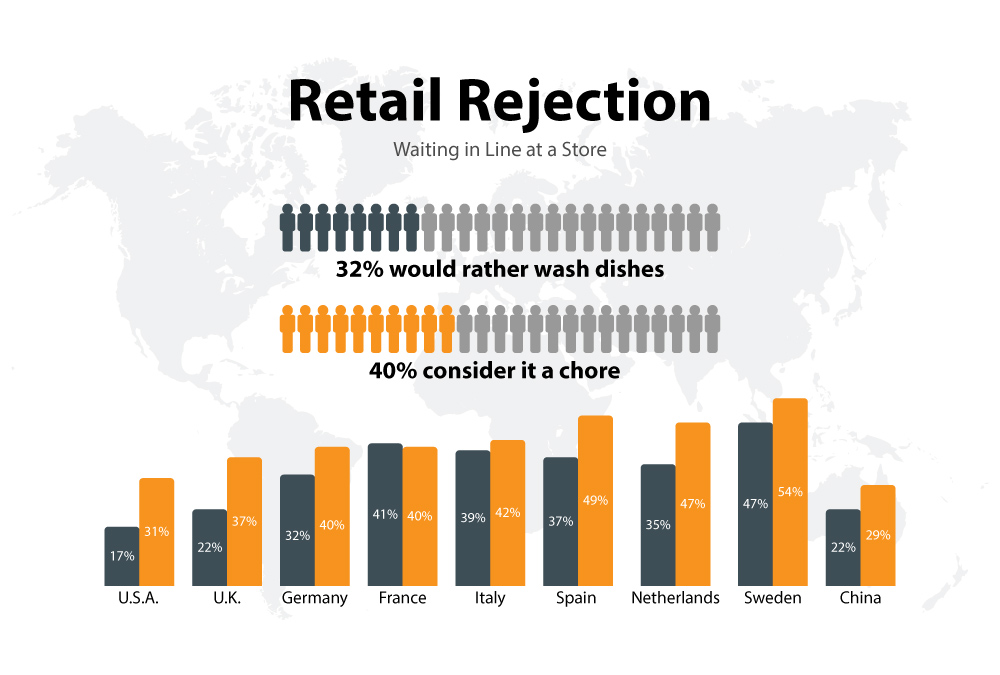Is Your Business Ready for the Future of Payments?
Depending on the source material, history shows some form of cash has been used to pay for goods and services for thousands of years: Metal coins date back to 1,000 BCE. In that time, the evolution of merchandising has moved from barter to coins to cash and checks to credit and debit cards to mobile payments, and most recently, to touch-free, biometrics and block chain. Never in those eons, has the future of payments been so murky, and astute merchants need to stay on top of the latest trends to remain relevant to their customers.
Over just the past three years, payment card technology has moved from magnetic strips to microchips in an effort to improve transaction data security. However, conversion to the new security measures and data encryption was expensive for merchants and it slowed their checkout process which threw a wrench in customers’ shopping experiences. The result was pushback from many retailers and slow adoption of the technology.
The technology has steadily improved and with the development of near field communication (NFC), which allows touchless payments, the use of mobile wallets, in which payment card information is stored on a mobile device, is rising as rapidly as a blue-chip stock. While all of this may sound like technology from Star Trek, it is currently available to merchants through many advanced digital solutions and point of sale systems.
According to a new study from U.K.-based Juniper Research, nearly 2.1 billion consumers worldwide will use a mobile wallet to make a payment in 2019. Just wave your phone at a point of sale terminal and head for the door. It can’t be a lot easier than that, which should appeal to customer-friendly merchants. PayPal, ApplePay and Google Pay are a few examples of these services, and it’s the latest step in the evolution of money, how it is used in retail, and the future of payments.
Business Insider calls the shift in the future of payment technology the biggest single transformation in payment processing in retail history. Just four years ago, Apple was the only mobile wallet available to consumers. Since then, Google, Samsung, Walmart, Chase Bank and others have followed suit, and BI Intelligence, Business Insider’s research service, estimates in-store tap-and-go payment volume to reach over $500 billion by 2020.
Mobile Wallet, Immobile Stores
Paying with a phone used to be the exclusive realm of eCommerce, but mobile wallets are changing the future of payments. Retail Dive found that while close to 70% of shoppers research products online, nearly 90% of buying still happens in bricks-and-mortar stores. Because of that trend, shoppers using mobile wallets are creating a certain amount of heartburn for retailers who aren’t ready for the technology.
“I’m not going to lie [advanced payments are] complicated. This is our biggest pain point,” Sandrine Deveaux, managing director of Store of the Future at Farfetch, said during a presentation at ShopTalk in March. “This is not only the biggest pain point of Farfetch, but of retail.”
 Farfetch, an online retail fashion platform that markets clothes from boutiques and custom brands around the world, ventured into bricks-and-mortar stores last year with its Store of the Future in London. The company launched the store due to shoppers’ proclivity for making many more purchases in stores than online.
Farfetch, an online retail fashion platform that markets clothes from boutiques and custom brands around the world, ventured into bricks-and-mortar stores last year with its Store of the Future in London. The company launched the store due to shoppers’ proclivity for making many more purchases in stores than online.
Keeping pace with payment technology doesn’t have to be painful, though. Independent retailers have many options for digital retail solutions that offer touchless checkout technology.
Painful Point
Many retailers are moving to touchless payment technology to streamline sales transactions for shoppers clamoring for shorter or non-existent checkout lines.
Just how much retail customers hate checkout lines is highlighted by a Capgemini Consulting survey of 6,000 consumers and 500 merchants that shows one-third of shoppers would rather wash dishes than wait in line, and nearly half consider shopping a chore.

Many large retailers such as Apple, Target, Kohl’s and Macy’s have moved to scan-and-go checkouts with NFC payment cards and mobile wallets the key to smoothing the process. Not all these attempts have been successful, though. In March, Walmart at least temporarily scrapped its Scan & Go program, which allowed customers to scan their items and pay for them with a smartphone app allowing them to skip checkout lines. Although the program was available in only a few stores, the company felt it needed more research and testing because it wasn’t being used very much.
Next Gen
As rapidly as retail technology is moving, merchants don’t need a crystal ball to see the future of payments. The Amazon Go store in Seattle is an example of where retail checkout could be headed. Billing itself as “the world’s most advanced shopping technology,” customers walk in, pick up items they want, and walk out. No checkout required. The store’s technology detects what products a customer takes and bills their Amazon account. All that is needed is the company’s free cell phone app.
The system uses cameras, facial recognition and shelf sensors to determine what items have been “purchased.” Standard Cognition, a San Francisco-based retail tech company, markets a similar system.
Biometrics will play a larger role in the future of payment technology. Much like fingerprints and DNA are so ingrained in personal identification, facial recognition software will be one of the keys in the new wave of customer checkout. People can already unlock their mobile phones just by looking at its screen. That’s why smart phones and mobile devices will play an even more significant role in how people shop.
“A retailer that thinks mobile won’t be a big part of [the checkout process] even in high touch environments isn’t understanding the way consumers interact now,” Tom Gehani, director of client strategy and research at L2, a subscription-based business intelligence service, tells Retail Dive.
Other Technologies
A few other future payment options could add to the technological mix.
Voice/Chat commerce is on the rise. The technology that allows people to ask Siri, Alexa and Google to make purchases, perform routine electronic home tasks and schedule appointments is already utilized by more than 39 million Americans.
Use of blockchain is also increasing. Blockchain is the key technology of Bitcoin, a type of digital currency that can be exchanged as payment independent of a central bank.
Global Perspective
While North America and Western Europe may consider themselves hubs of technology and commerce, China leads the way in proximity mobile payment adoption, also known as mobile wallets. According to the Global Proximity Mobile Payment Users report from eMarketer, China accounts for more than 61% of proximity mobile payment users.
The report shows that 2018 will mark the first time more than one-third of smartphone users 14 and older make at least two purchases at a physical point of sale with their phones. Mobile proximity payments are expected to be driven by a handful of global providers including Android Pay, Apple Pay, Samsung Pay, Alipay and WeChat Pay.
Future Shoppers
The latest generation – Generation Z – loves shopping in stores, and, according to a recent study from Accenture, they visit bank branches more often than any other age group, even Baby Boomers. Gen Z is projected to be 40% of all U.S. consumers by 2020.
This group doesn’t know what it’s like to live without Google, Facebook, Amazon and their precious mobile phones. More than any previous generation, Gen Z craves immediacy and, despite its members’ tendency to shop in bricks-and-mortar stores and visit banks, they will most likely be the first generation to embrace the future of payments and ditch their cash and leather wallets for mobile versions.
Approximately 80% already say they would give up television for a day, and 28% would give up friends and money to keep their mobile phones, which contain most of their identity.
P2P Payments
In a world of increasing interconnectivity, U.S. banks last year launched Zelle, service that allows people with digital access to their bank accounts to transfer money to another individual using a mobile device or website. The person-to-person (P2P) service is available to individuals with MasterCard or Visa-branded payment cards with U.S. bank accounts. PayPal offers a similar service called Venmo.
These services allow almost anyone to accept digital payments for goods or services which should further reduce the use of coins and bills.
Fist Full of Dollars
“Do I think cash is dead? No,” Peter Caparso, Checkout.com’s president of North America, tells Retail Dive. “Do I think it’ll be greatly diminished? Yes. Until 2007, after the invention of the phone in 1876, you were tethered to a five-foot semi-circle to talk. Now this younger generation, they’re used to the convenience and the portability of the phone, and that’s translating to the retail arena.”
That means retailers who aren’t ready for the digital payment movement need to get moving. According to Bluesnap data, a global payments company, digital wallet payment spending increased 114% from the last quarter of 2017 to the first quarter of 2018. During that period, the number of transactions increased 38% and the average sale total rose 55%.
Even though the future of payments is headed toward an electronic future, experts say cash will still be king. Just think of all the items that are purchased and services that are rendered on a cash-only basis. Many people trust more in cash than they do in their banks and governments. And, the number of people who worry about having their financial information hacked is incredibly high.
A Gallup poll not too many years ago revealed that Americans worry more about having their financial information hacked (62%) than they do about having their home burglarized (45%), being a victim of terrorism (28%) or even murdered (18%). The second most feared crime – 62% of those polled – is having a computer or smartphone hacked.
What’s a Merchant to do?
Payment card company Visa has established 10 innovation centers around the world to showcase its view of the future of payments. The centers replicate shopping scenarios – a coffee shop, a public transit terminal, a sporting goods and athletic apparel store and more – all equipped with the latest touch-free payment technology. Smartphones, watches and tablets are used to pay for all sorts of goods and services.
Moving to touch-free payments isn’t a great leap for merchants who have invested in upgrading their point of sale systems. Many systems that utilize payment terminals such as Ingenico, Square, PayPal and others already have touch-free payment capabilities.
No matter what your beliefs, opinions or preferences, merchants need to set themselves up for the digital payment movement or get left behind.
Brian Bullock
Author


